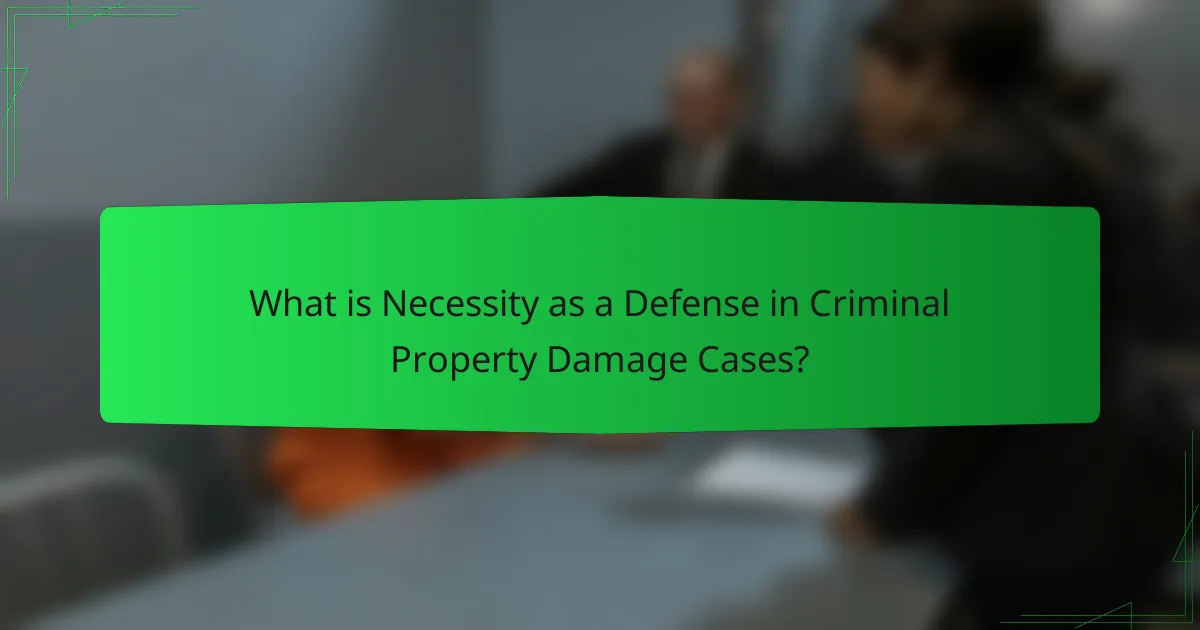Necessity as a defense in criminal property damage cases is a legal justification for actions taken to avert greater harm. This defense posits that a defendant may damage property to prevent an imminent and significant threat, with the harm avoided being greater than the harm caused. Courts assess the reasonableness of the defendant’s belief in the necessity of their actions, which can lead to acquittal or reduced charges if successful. Key examples include breaking a window to rescue someone from a fire or damaging a fence to access emergency services. Individuals involved in such cases should gather evidence, document circumstances, and consult legal professionals to strengthen their defense. Understanding the legal standards and preparing a clear narrative are essential for effectively presenting the necessity defense.

What is Necessity as a Defense in Criminal Property Damage Cases?
Necessity as a defense in criminal property damage cases refers to a legal justification for actions taken to prevent greater harm. This defense argues that the defendant was compelled to damage property to avoid an imminent and significant threat. The necessity must be immediate and the harm avoided must be greater than the harm caused. Courts often evaluate the reasonableness of the defendant’s belief in the necessity of their actions. If the defense is successful, it may result in acquittal or reduced charges. The concept is rooted in the principle of preventing greater evils and is recognized in many legal systems.
How is Necessity defined in legal terms?
Necessity in legal terms is defined as a defense used to justify actions taken to prevent greater harm. This defense asserts that the defendant acted to avert an imminent danger that could not be avoided by any other means. Legal systems recognize necessity as a valid justification under certain conditions. For example, the harm avoided must be greater than the harm caused by the defendant’s actions. Courts generally require that the situation be urgent, leaving no reasonable alternative. The necessity defense is often applied in cases involving property damage where immediate action is needed to prevent greater injury or loss. This legal concept is rooted in the principle of proportionality, emphasizing that the response must be appropriate to the threat faced.
What are the key legal principles behind Necessity?
The key legal principles behind Necessity include the justification of actions taken to prevent greater harm. Necessity operates under the premise that an individual may break the law to avoid an imminent and greater threat. The principle requires that the harm avoided outweighs the harm caused by the unlawful act. Additionally, the threat must be immediate and not speculative. The individual must have no reasonable legal alternative to their actions. Courts often assess the proportionality of the response to the threat. Historical cases, such as *R v. Dudley and Stephens*, illustrate these principles in practice. In that case, necessity was not accepted as a defense for murder, emphasizing the strict limitations of the doctrine.
How does Necessity differ from other defenses?
Necessity differs from other defenses by focusing on the immediate need to prevent greater harm. In necessity, the defendant argues that their illegal action was taken to avoid a more significant danger. This contrasts with defenses like self-defense, which justifies actions taken in response to an immediate threat to oneself. Necessity is often applied in cases where the harm avoided is more severe than the harm caused by the illegal act. For example, breaking into a cabin to escape a blizzard demonstrates necessity, as it prevents life-threatening exposure. Other defenses, such as duress, require coercion or threats, while necessity emphasizes the urgency of the situation. Courts evaluate necessity based on the circumstances and the balance of harms involved.
Why is Necessity considered a valid defense?
Necessity is considered a valid defense because it justifies actions taken to prevent greater harm. This legal principle allows individuals to argue that they acted out of an urgent need to avoid significant danger. In many jurisdictions, the necessity defense applies when a person breaks the law to prevent imminent harm to themselves or others. The harm avoided must be greater than the harm caused by the illegal act. Courts evaluate necessity claims based on the specific circumstances of each case. For example, if someone damages property to save a life, the necessity defense may be invoked. Historical cases demonstrate that courts often accept necessity when it is clearly established that no reasonable legal alternatives existed.
What are the circumstances that justify the use of Necessity?
The circumstances that justify the use of Necessity include an immediate threat to life or safety. This defense applies when a person must act to prevent greater harm. The action taken must be reasonable and proportional to the threat faced. For example, breaking into a building to escape a fire can be justified. The necessity must be clear and urgent, leaving no reasonable alternative. Courts often evaluate these cases based on the specific facts presented. Historical cases illustrate these principles, such as the necessity defense being upheld in situations of emergency.
How does Necessity protect defendants in property damage cases?
Necessity can protect defendants in property damage cases by providing a legal defense that justifies their actions. This defense argues that the defendant’s property damage was necessary to prevent a greater harm. For example, if a person damages property to escape a dangerous situation, necessity may apply. Courts typically evaluate whether the harm avoided was greater than the harm caused. The defendant must demonstrate that no reasonable alternative existed to prevent the harm. This defense is rooted in the principle that actions taken to avert a significant threat can be justified. In case law, necessity has been recognized as a valid defense in various jurisdictions.
What are the key elements of Necessity as a defense?
The key elements of Necessity as a defense include an imminent threat, no reasonable alternative, and proportionality. The defendant must demonstrate that they faced an immediate danger that required action. This danger must be significant and unavoidable. The defendant must also show that there were no legal alternatives to their actions. This means that the defendant had to act to prevent greater harm. Additionally, the actions taken must be proportional to the threat faced. This means that the harm caused by the defendant should not outweigh the harm avoided. Courts evaluate these elements to determine if the defense of necessity is applicable.
What must a defendant prove to successfully claim Necessity?
A defendant must prove that their actions were necessary to prevent a greater harm. This involves demonstrating an imminent threat to themselves or others. The defendant must show that no legal alternatives were available. The harm avoided must be greater than the harm caused by their actions. The defendant’s response must be proportional to the threat faced. Evidence supporting these claims can include witness testimony or expert opinions. Legal precedents often support these requirements in necessity claims.
How do the elements of Necessity vary by jurisdiction?
The elements of Necessity vary significantly by jurisdiction. In some jurisdictions, the necessity defense requires an imminent threat to life or property. Other jurisdictions may accept a broader range of circumstances. For instance, California emphasizes the necessity must be reasonable and proportionate. In contrast, New York requires a clear and immediate danger. Additionally, some jurisdictions impose a requirement of no legal alternatives. The variations reflect differing legal standards and interpretations. These differences can impact the outcome of cases involving the necessity defense. Understanding these nuances is crucial for legal practitioners.

What are the examples of Necessity in Criminal Property Damage Cases?
Examples of necessity in criminal property damage cases include breaking a window to rescue someone from a fire. Another example is damaging a fence to access emergency services during a medical crisis. Additionally, a person may damage a door to escape an immediate threat. These actions are often justified under the necessity defense in legal contexts. Courts evaluate the immediacy and severity of the threat when considering such defenses.
How have courts applied Necessity in real cases?
Courts have applied the necessity defense in various real cases involving criminal property damage. In the case of *United States v. Schoon*, the Ninth Circuit upheld the necessity defense for individuals who damaged property to prevent greater harm. The court ruled that the defendants acted to avert an imminent threat to the environment. Another notable case is *State v. Hinkle*, where the court allowed the necessity defense for a defendant who damaged a fence to rescue a child from a dangerous situation. The court emphasized the importance of proportionality in assessing the necessity of the action taken. In *People v. McCoy*, the court recognized the necessity defense when a defendant destroyed property to prevent a fire from spreading. These cases illustrate how courts evaluate the immediacy of the threat and the balance of harms when applying the necessity defense.
What are notable case studies that illustrate Necessity?
Notable case studies that illustrate Necessity include the case of *United States v. McBratney* and *State v. Dorsey*. In *United States v. McBratney*, the defendant damaged property to prevent greater harm during an emergency. The court recognized the necessity defense when the action was aimed at averting imminent danger. In *State v. Dorsey*, the defendant broke into a building to seek shelter from a life-threatening storm. The court ruled that necessity justified the property damage due to the life-threatening circumstances. These cases demonstrate how necessity can serve as a valid defense in criminal property damage situations.
What lessons can be learned from these case examples?
Lessons from case examples highlight the importance of context in necessity defenses. Each case illustrates that the perceived threat must be immediate and significant. The actions taken must be proportional to the harm avoided. Courts often evaluate whether a reasonable person would act similarly under the same circumstances. Successful defenses typically require clear evidence of urgency. Additionally, the legality of the actions taken is scrutinized. Understanding these factors can guide future legal strategies in similar cases.
What challenges do defendants face when using Necessity as a defense?
Defendants face several challenges when using Necessity as a defense. One major challenge is proving the imminent threat that justified their actions. They must demonstrate that the harm they prevented was greater than the harm caused by their illegal act. This often requires clear, compelling evidence. Additionally, defendants must show that no legal alternatives were available to avoid the harm. This can be difficult, as the court may scrutinize the actions taken. The subjective nature of Necessity can also lead to varying interpretations by judges and juries. This inconsistency can affect the outcome of the case. Lastly, public perception and moral judgments may influence the court’s decision, complicating the defense further.
What are common misconceptions about the Necessity defense?
Common misconceptions about the Necessity defense include the belief that it can justify any illegal act. In reality, the defense is only applicable in specific circumstances. Another misconception is that individuals can claim Necessity for actions taken out of convenience. However, the defense requires an imminent threat to life or safety. Many think that the Necessity defense is a blanket excuse for all criminal behavior. This is incorrect, as it must meet strict legal criteria. Additionally, some believe that the Necessity defense is easily accepted in court. In practice, it is often challenging to prove and rarely succeeds. Misunderstanding these aspects can lead to misapplication in legal contexts.
How can defendants effectively present their Necessity claims?
Defendants can effectively present their Necessity claims by clearly demonstrating the imminent threat they faced. They must show that their actions were necessary to prevent greater harm. This involves providing evidence of the specific circumstances that led to their decision. Defendants should gather witness testimonies to support their claims. They can also present expert opinions on the situation’s urgency. Documenting any relevant communications or warnings can strengthen their case. Additionally, they should ensure that their actions were proportional to the threat. Courts often require a detailed explanation of the decision-making process involved.

How can individuals prepare for cases involving Necessity as a defense?
Individuals can prepare for cases involving Necessity as a defense by gathering evidence that demonstrates the urgency of the situation. They should document the circumstances leading to the actions taken. This includes collecting witness statements and photographs of the scene. Individuals must also understand the legal standards for Necessity in their jurisdiction. Familiarity with relevant case law can strengthen their position. Consulting with a legal professional experienced in criminal defense is essential. They can provide tailored advice and help build a strong case. Preparing a clear narrative that explains the necessity of actions taken is crucial. This narrative should highlight the imminent harm that was avoided.
What steps should defendants take when considering Necessity?
Defendants should evaluate the situation to determine if necessity applies. They must identify the immediate danger requiring action. Next, they should assess whether the action taken was necessary to prevent greater harm. Defendants need to ensure that the harm caused is proportional to the harm avoided. Documenting evidence supporting the necessity claim is crucial. This includes gathering witness statements and any relevant records. Consulting with legal counsel can help clarify the application of necessity in their case. Finally, defendants must prepare to present their defense effectively in court.
What role does legal counsel play in establishing a Necessity defense?
Legal counsel plays a crucial role in establishing a Necessity defense. They help define the legal parameters of the defense. Legal counsel gathers evidence to support claims of imminent harm. They analyze the situation to demonstrate that illegal actions were necessary to prevent greater harm. Counsel also prepares legal arguments to present in court. They ensure that the defense meets jurisdictional requirements. Additionally, legal counsel advises clients on potential outcomes and risks. Their expertise is vital in navigating complex legal standards associated with Necessity defenses.
How can defendants gather evidence to support their claims?
Defendants can gather evidence to support their claims by collecting documentation, witness statements, and expert opinions. They should compile relevant records such as emails, contracts, and photographs. Witness statements can provide firsthand accounts that corroborate the defendant’s position. Expert opinions may include analysis from professionals in relevant fields, adding credibility to the claims. Additionally, surveillance footage can serve as visual evidence supporting the defendant’s narrative. Gathering this evidence should be done systematically to ensure it is admissible in court. Each piece of evidence must be organized and presented clearly to strengthen the defense’s case.
What best practices should be followed in Necessity cases?
In Necessity cases, the best practices include establishing an immediate threat to life or safety. The defendant must demonstrate that the harm caused was less than the harm avoided. Evidence should support the claim of necessity, including witness testimonies or documentation. The action taken must be proportionate to the threat faced. It is crucial to show that no legal alternatives were available to prevent the harm. Additionally, the defendant should act with reasonable care and avoid reckless behavior. Courts often require clear and convincing evidence to validate the necessity defense. These practices align with legal precedents and guidelines established in criminal law.
How can defendants strengthen their arguments for Necessity?
Defendants can strengthen their arguments for Necessity by clearly demonstrating an imminent threat. They must provide evidence that the harm avoided was greater than the harm caused. Establishing a direct connection between their actions and the necessity to act is crucial. Defendants should also show that no legal alternatives were available to prevent the harm. Presenting credible witnesses can support their claims effectively. Documenting the circumstances leading to the action is essential for credibility. Courts often look for a reasonable belief that the action was necessary. This approach aligns with legal precedents that validate the necessity defense in similar cases.
What are the potential outcomes in successful Necessity defenses?
Successful necessity defenses can lead to the dismissal of charges. This outcome occurs when the defendant proves that their actions were necessary to prevent a greater harm. Courts evaluate the immediacy and severity of the threat faced by the defendant. If the necessity is established, the legal system may recognize the act as justified. This can result in acquittal or reduced penalties. Historical cases illustrate this principle, such as in the case of *United States v. Holmes*, where necessity was accepted as a defense. Overall, successful necessity defenses can significantly alter the legal consequences for defendants.
The main entity of the article is “Necessity as a Defense in Criminal Property Damage Cases.” The article provides a comprehensive overview of the legal concept of necessity, explaining how it serves as a defense for individuals who damage property to prevent greater harm. Key elements discussed include the definition of necessity, the legal principles that underpin it, and the circumstances under which it is considered valid. It also highlights notable case studies, challenges defendants face, and best practices for effectively presenting necessity claims in court. Through this exploration, the article aims to clarify the nuances of the necessity defense and its application in various legal contexts.